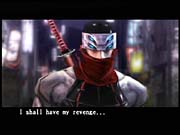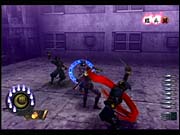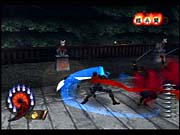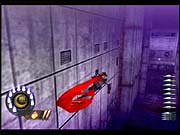Shinobi Preview
Sega revives its classic ninja franchise on the PlayStation 2.
Back in the days before games took a realistic approach in portraying ninjas, the Japanese assassins were represented as aggressive killing machines with all the subtlety of the soldiers in Contra. One of the most memorable ninja franchises was Sega's Shinobi, which appeared in arcades, on Sega's home consoles, and on a few non-Sega consoles such as the TurboGrafx-16 . The games centered around Joe Musashi, a ninja out to fight against the forces of evil, and featured side-scrolling gameplay with some vehicle sequences thrown in for variety. Despite its various incarnations, the series went quiet and appeared to fade into the annals of gaming history following the the Saturn game in 1995. Fortunately, as Sega mines its catalog of games for multiplatform development, the series is being reborn courtesy of Overworks. We had a chance to try out a previewable build of the game to see how the series was making the leap to 3D.

Shinobi's makeover involves more than a simple cosmetic switch to the third dimension and extends to every facet of the game. Rather than feature the return of Joe Musashi, the game focuses on a new ninja named Hotsuma, who's having a really bad run of luck. The poor guy is the last surviving member of the Oboro clan, which was unceremoniously wiped out, and he's being tapped to investigate some seriously bizarre occurrences in Tokyo. As if that weren't bad enough, the evil forces behind the strange goings-on have reanimated his clan and are using them to stop Hotsuma. The final kick in the pants comes when Hotsuma's sword is cursed. While you'd think a powerful ninja sword with a curse would come in handy when you're facing off against your undead brothers, the fact that it will drain your life if not fed the energy from a kill makes it a dubious comfort at best.

Shinobi's structure is pretty straightforward and stays true to the previous Shinobi games. You'll go through a linear series of themed levels that are broken up into at least two smaller segments by barriers that drop once you've cleared the area of all enemies. As you progress through each level you'll find a boss character that will have to be dispatched before you can go any further. Along the way, slain enemies will drop shuriken, energy to be absorbed by your sword once it's cursed, and health power-ups. You'll also be able to find scrolls that let you use magic and Oboro clan coins that will unlock extras in the game.
While the road to the truth will be a challenging one, Hotsuma has a respectable set of skills tailor-made to dispatch the forces of evil. Luckily you won't need to be too much of a ninja to get a handle on them. You'll move Hotsuma with the left analog stick and jump with the O button. The R1 button will lock you on to your enemies and keep your movement relative to them as long as the lock is active. R2 will let you cycle between enemies once you've locked on to one. You'll have two attack options to choose from during a fight: The square button will let you use Hotsuma's sword to slash at enemies, while the triangle button will pitch shuriken at your foes. As in the 2D installments in the series, you'll be able to fire off a wide arc of shuriken by hitting the triangle button during a double jump. The L2 button will trigger whatever spell Hotsuma currently has selected, and you'll be able to cycle through your stock by using the D-pad. A new addition to gameplay is the dash move, which is triggered by the X button.
A Walking Ginzu Knife
The dash is a multipurpose move that comes in very handy. Dashing on the ground will let you shoot forward faster than a speeding bullet, leaving nothing but a ghostly afterimage. Dashing in the air does the same, although, if done in combination with the double jump, it can also extend your jumping range. Air dashing complements Hotsuma's ability to run on walls nicely and lets you ricochet off walls in order to reach new areas or gain altitude. Dashing when you're locked on to enemies will let you zip around them to avoid attack or come at them from a different angle to get past their defenses. Another useful addition is the tate, which is an attack combo that just looks cool. When you're attacked by a group of enemies, you'll notice that a group of Japanese characters will appear in the upper left-hand corner. The characters correspond to the enemies you're facing and will light up as you take them out. If there are at least four and you manage to take out all the enemies in time, thus lighting up all the characters, you'll be treated to a cool cinematic sequence.

The game's graphics are coming together quite well and have a slick, stylized look. The levels are tightly designed, with a distinct path through them, although you'll find some hidden nooks and crannies that yield some prizes if you explore. The varied locales for the levels in the game are well done and are quite detailed. You'll see legible neon signs in the city and graffiti lining the walls in the subways. You'll also find an assortment of breakable objects to interact with in the game, which is a nice touch. The enemies you'll encounter in the game are a mix of flying hell spawn, ghostly wolves, Oboro clan members, and other assorted mystical hazards. Overall, detail on the enemies is simple but clean and does a fine job of reflecting their mystical origins. As for Hotsuma himself, you won't find a sharper-dressed ninja around. Hotsuma looks and moves great, and his detailed character model is highlighted by a flowing red scarf. The tate moves and slick spell effects work together to make Hotsuma look like the baddest ninja ever to stab a demon. While some of the geometry in the game is a bit blocky in places, it fits with the game's overall style.

As far as the music and sound go, Hotsuma is a bipolar kind of guy. While he's quite chatty in the cutscenes and CG sequences that propel the story forward, he's pretty silent except for the odd grunt during gameplay. The same can be said for most of his foes, who do a bit of screeching and/or howling in death but are pretty quiet otherwise. Fortunately the game's music, which is a techno-influenced collection of tunes reminiscent of some of the classic Shinobi game tunes, is an engaging mix that suits the action. The only minor gripe we have with the game's sound right now--the weak voice acting--has already been addressed, thanks to the inclusion of a Japanese-voice/English-subtitle option.
We have to say that we are impressed by what we've seen of the game so far. Overworks has done an excellent job of updating the franchise. The game manages to retain the speed and feel of the 2D games while taking the gameplay into 3D. There are some camera issues, like in any other 3D game--most notably some awkward angles during a tate--though the ability to center the camera behind you with the L1 button and move it on the fly with the right analog stick helps keep camera weirdness under control, for the most part. Otherwise, the game looks good and handles well. We're most pleased with the gameplay and its emphasis on high-speed killing and movement instead of stealth. Fans of the original Shinobi or anyone looking for an arcade-style action game should be on the lookout for this game. Shinobi is slated to ship this November for the PlayStation 2.
Got a news tip or want to contact us directly? Email news@gamespot.com
Join the conversation